6--试题及答案
- 格式:doc
- 大小:30.00 KB
- 文档页数:2
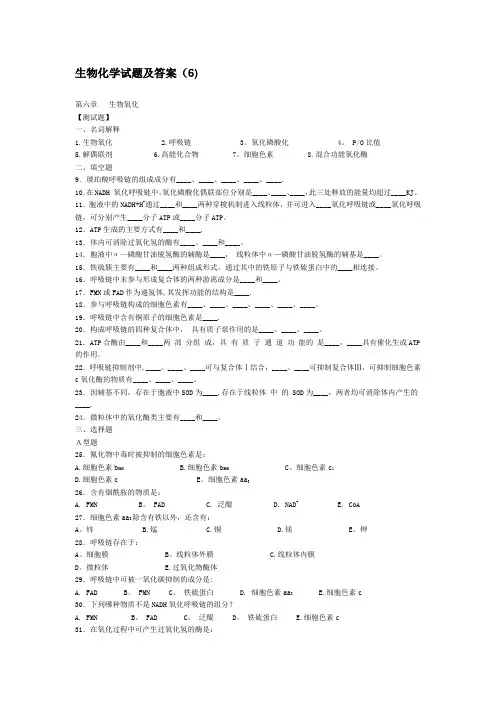
生物化学试题及答案(6)第六章生物氧化【测试题】一、名词解释1.生物氧化2.呼吸链3。
氧化磷酸化4。
P/O比值5.解偶联剂6.高能化合物7。
细胞色素8.混合功能氧化酶二、填空题9.琥珀酸呼吸链的组成成分有____、____、____、____、____.10.在NADH 氧化呼吸链中,氧化磷酸化偶联部位分别是____、____、____,此三处释放的能量均超过____KJ。
11.胞液中的NADH+H+通过____和____两种穿梭机制进入线粒体,并可进入____氧化呼吸链或____氧化呼吸链,可分别产生____分子ATP或____分子ATP。
12.ATP生成的主要方式有____和____.13.体内可消除过氧化氢的酶有____、____和____。
14.胞液中α—磷酸甘油脱氢酶的辅酶是____,线粒体中α—磷酸甘油脱氢酶的辅基是____。
15.铁硫簇主要有____和____两种组成形式,通过其中的铁原子与铁硫蛋白中的____相连接。
16.呼吸链中未参与形成复合体的两种游离成分是____和____。
17.FMN或FAD作为递氢体,其发挥功能的结构是____.18.参与呼吸链构成的细胞色素有____、____、____、____、____、____。
19.呼吸链中含有铜原子的细胞色素是____.20.构成呼吸链的四种复合体中,具有质子泵作用的是____、____、____。
21.ATP合酶由____和____两部分组成,具有质子通道功能的是____,____具有催化生成ATP 的作用。
22.呼吸链抑制剂中,____、____、____可与复合体Ⅰ结合,____、____可抑制复合体Ⅲ,可抑制细胞色素c氧化酶的物质有____、____、____。
23.因辅基不同,存在于胞液中SOD为____,存在于线粒体中的 SOD为____,两者均可消除体内产生的____.24.微粒体中的氧化酶类主要有____和____。
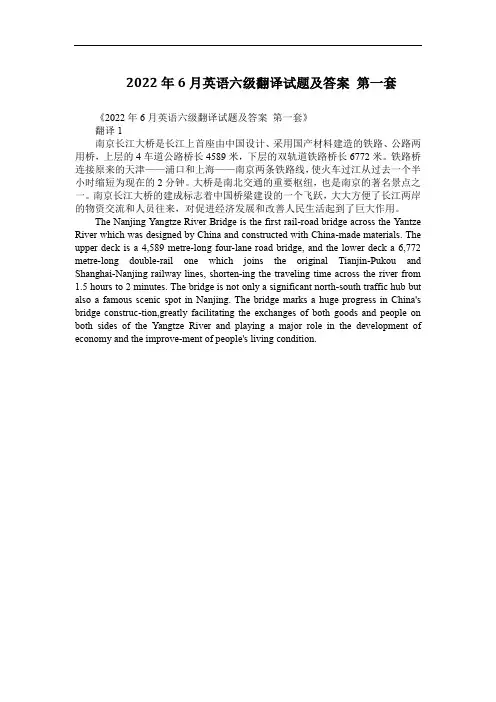
2022年6月英语六级翻译试题及答案第一套《2022年6月英语六级翻译试题及答案第一套》翻译1南京长江大桥是长江上首座由中国设计、采用国产材料建造的铁路、公路两用桥,上层的4车道公路桥长4589米,下层的双轨道铁路桥长6772米。
铁路桥连接原来的天津——浦口和上海——南京两条铁路线,使火车过江从过去一个半小时缩短为现在的2分钟。
大桥是南北交通的重要枢纽,也是南京的著名景点之一。
南京长江大桥的建成标志着中国桥梁建设的一个飞跃,大大方便了长江两岸的物资交流和人员往来,对促进经济发展和改善人民生活起到了巨大作用。
The Nanjing Yangtze River Bridge is the first rail-road bridge across the Yantze River which was designed by China and constructed with China-made materials. The upper deck is a 4,589 metre-long four-lane road bridge, and the lower deck a 6,772 metre-long double-rail one which joins the original Tianjin-Pukou and Shanghai-Nanjing railway lines, shorten-ing the traveling time across the river from 1.5 hours to 2 minutes. The bridge is not only a significant north-south traffic hub but also a famous scenic spot in Nanjing. The bridge marks a huge progress in China's bridge construc-tion,greatly facilitating the exchanges of both goods and people on both sides of the Yangtze River and playing a major role in the development of economy and the improve-ment of people's living condition.。
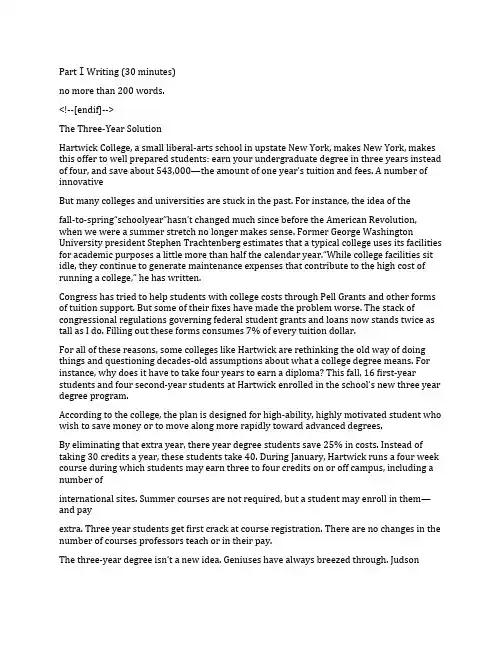
Part Writing (30 minutes)Ⅰno more than 200 words.<!--[endif]-->The Three-Year SolutionHartwick College, a small liberal-arts school in upstate New York, makes New York, makes this offer to well prepared students: earn your undergraduate degree in three years instead of four, and save about 543,000—the amount of one year’s tuition and fees. A number of innovativeBut many colleges and universities are stuck in the past. For instance, the idea of thefall-to-spring“schoolyear”hasn’t changed much since before the American Revolution, when we were a summer stretch no longer makes sense. Former George Washington University president Stephen Trachtenberg estimates that a typical college uses its facilities for academic purposes a little more than half the calendar year.“While college facilities sit idle, they continue to generate maintenance expenses that contribute to the high cost of running a college,” he has written.Congress has tried to help students with college costs through Pell Grants and other forms of tuition support. But some of their fixes have made the problem worse. The stack of congressional regulations governing federal student grants and loans now stands twice as tall as I do. Filling out these forms consumes 7% of every tuition dollar.For all of these reasons, some colleges like Hartwick are rethinking the old way of doing things and questioning decades-old assumptions about what a college degree means. For instance, why does it have to take four years to earn a diploma? This fall, 16 first-year students and four second-year students at Hartwick enrolled in the school’s new three year degree program.According to the college, the plan is designed for high-ability, highly motivated student who wish to save money or to move along more rapidly toward advanced degrees.By eliminating that extra year, there year degree students save 25% in costs. Instead of taking 30 credits a year, these students take 40. During January, Hartwick runs a four week course during which students may earn three to four credits on or off campus, including a number ofinternational sites. Summer courses are not required, but a student may enroll in them—and payextra. Three year students get first crack at course registration. There are no changes in the number of courses professors teach or in their pay.The three-year degree isn’t a new idea. Geniuses have always breezed through. JudsonCollege, a 350-student institution in Alabama, has offered students a three-year option for40 years. Students attend “short terms” in May and June to earn the credits required for graduation. Bates College in Maine and Ball State University in Indiana are among othercolleges offering three-year options.Advanced Placement (AP) credits amounting to a semester or more of college level work.Many universities, including large schools like the University of Texas, make it easy for these AP students to graduate faster.professor’s class. Iowa’s Waldorf College has graduated several hundred students in its three-year degree program, but it now phasing out the option. Most Waldorf students wanted the fullfour-year experience—academically, socially, and athletically. And faculty members will bewary of any change that threatens the core curriculum in the name of moving students into the workforce.Expanding the three-year option may be difficult, but it may be less difficult than asking bright, motivated students. These sorts of innovations can help American universities avoid the perils of success.注意:此部分试题请在答题卡1上作答。
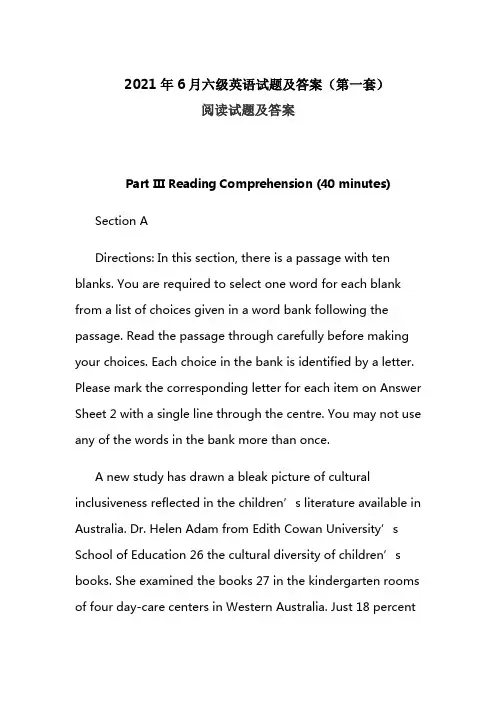
2021年6月六级英语试题及答案(第一套)阅读试题及答案Part III Reading Comprehension (40 minutes)Section ADirections: In this section, there is a passage with ten blanks. You are required to select one word for each blank from a list of choices given in a word bank following the passage. Read the passage through carefully before making your choices. Each choice in the bank is identified by a letter. Please mark the corresponding letter for each item on Answer Sheet 2 with a single line through the centre. You may not use any of the words in the bank more than once.A new study has drawn a bleak picture of cultural inclusiveness reflected in the children’s literature available in Australia. Dr. Helen Adam from Edith Cowan University’s School of Education 26 the cultural diversity of children’s books. She examined the books 27 in the kindergarten rooms of four day-care centers in Western Australia. Just 18 percentof 2,413 books in the total collection contained any 28 of non-white people. Minority cultures were often featured in stereotypical or tokenistic ways, for example, by 29 Asian culture with chopsticks and traditional dress. Characters that did represent a minority culture usually had 30 roles in the books. The main characters were mostly Caucasian. This causes concern as it can lead to an impression that whiteness is of greater value.Dr. Adam said children formed impressions about “difference” and identity from a very young age. Evidence has shown they develop own-race 31 from as young as three months of age. The books we share with young children can be a valuable opportunity to develop children’s understanding of themselves and others. Books can also allow children to see diversity. They discover both similarities and differences between themselves and others. This can help develop understanding, acceptance and 32 of diversity.Census data has shown Australians come from more than 200 countries. They speak over 300 languages at home. Additionally, Australians belong to more than 100 different religious groups. They also work in more than 1,000 differentoccupations. “Australia is a multicultural society. The current33 promotion of white middle-class ideas and lifestyles risks34 children from minority groups. This can give white middle-class children a sense of 35 or privilege,” Dr. Adam said.A) alienatingB) appreciationC) biasD) fraudE) housedF) investigatedG) overwhelming。
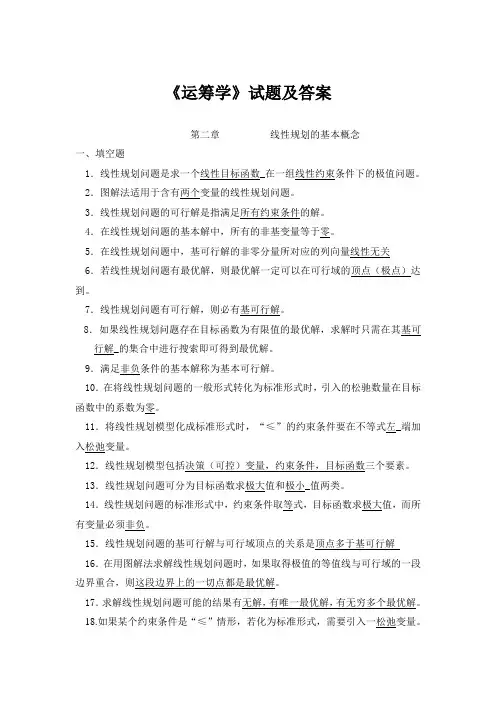
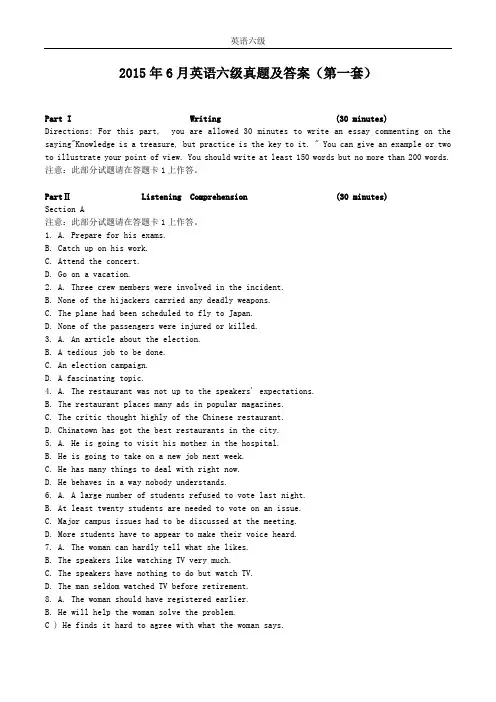
2015年6月英语六级真题及答案(第一套)Part I Writing (30 minutes)Directions: For this part, you are allowed 30 minutes to write an essay commenting on the saying"Knowledge is a treasure, but practice is the key to it. " You can give an example or twoto illustrate your point of view. You should write at least 150 words but no more than 200 words. 注意:此部分试题请在答题卡1上作答。
PartⅡ Listening Comprehension (30 minutes)Section A注意:此部分试题请在答题卡1上作答。
1. A. Prepare for his exams.B. Catch up on his work.C. Attend the concert.D. Go on a vacation.2. A. Three crew members were involved in the incident.B. None of the hijackers carried any deadly weapons.C. The plane had been scheduled to fly to Japan.D. None of the passengers were injured or killed.3. A. An article about the election.B. A tedious job to be done.C. An election campaign.D. A fascinating topic.4. A. The restaurant was not up to the speakers' expectations.B. The restaurant places many ads in popular magazines.C. The critic thought highly of the Chinese restaurant.D. Chinatown has got the best restaurants in the city.5. A. He is going to visit his mother in the hospital.B. He is going to take on a new job next week.C. He has many things to deal with right now.D. He behaves in a way nobody understands.6. A. A large number of students refused to vote last night.B. At least twenty students are needed to vote on an issue.C. Major campus issues had to be discussed at the meeting.D. More students have to appear to make their voice heard.7. A. The woman can hardly tell what she likes.B. The speakers like watching TV very much.C. The speakers have nothing to do but watch TV.D. The man seldom watched TV before retirement.8. A. The woman should have registered earlier.B. He will help the woman solve the problem.C ) He finds it hard to agree with what the woman says.D. The woman will be able to attend the classes she wants.Questions 9 to 12 are based on the conversation you have just heard.9. A. Persuade the man to join her company.B. Employ the most up-to-date technology.C. Export bikes to foreign markets.D. Expand their domestic business.10. A. The state subsidizes small and medium enterprises.B. The government has control over bicycle imports.C. They can compete with the best domestic manufacturers.D. They have a cost advantage and can charge higher prices.11. A. Extra costs might eat up their profits abroad.B. More workers will be needed to do packaging.C. They might lose to foreign bike manufacturers.D. It is very difficult to find suitable local agents.12. A. Report to the management.B. Attract foreign investments.C. Conduct a feasibility studyD. Consult financial experts.Questions 13 to 15 are based on the conversation you have just heard.13. A. Coal burnt daily for the comfort of our homes.B. Anything that can be used to produce power.C. Fuel refined from oil extracted from underground.D. Electricity that keeps all kinds of machines running.14. A. Oil will soon be replaced by alternative energy sources.B. Oil reserves in the world will be exhausted in a decade.C. Oil consumption has given rise to many global problems.D. Oil production will begin to decline worldwide by 2025.15. A. Minimize the use of fossil fuels.B. Start developing alternative fuels.C. Find the real cause for global warming.D. Take steps to reduce the greenhouse effect.Section BDirections: In this section, you will hear 3 short passages. At the end of each passage, you will hear some questions. Both the passage and the questions will be spoken only once. After you hear a question, you must choose the best answer from the four choices marked A ), B ), C. and D ). Then mark the corresponding letter on Answer Sheet 71 with a single line through the centre. 注意:此部分试题请在答题卡1上作答。
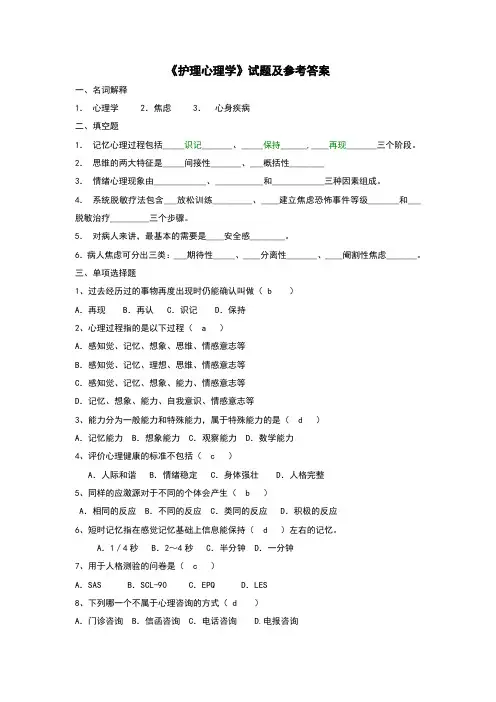
《护理心理学》试题及参考答案一、名词解释1.心理学 2.焦虑 3.心身疾病二、填空题1.记忆心理过程包括_____识记_______、_____保持______,____再现_______三个阶段。
2.思维的两大特征是_____间接性_______、___概括性________3.情绪心理现象由____________、___________和____________三种因素组成。
4.系统脱敏疗法包含___放松训练_________、____建立焦虑恐怖事件等级_______和___脱敏治疗_________三个步骤。
5.对病人来讲,最基本的需要是____安全感________。
6.病人焦虑可分出三类:___期待性_____、____分离性_______、____阉割性焦虑_______。
三、单项选择题1、过去经历过的事物再度出现时仍能确认叫做( b )A.再现 B.再认 C.识记 D.保持2、心理过程指的是以下过程( a )A.感知觉、记忆、想象、思维、情感意志等B.感知觉、记忆、理想、思维、情感意志等C.感知觉、记忆、想象、能力、情感意志等D.记忆、想象、能力、自我意识、情感意志等3、能力分为一般能力和特殊能力,属于特殊能力的是( d )A.记忆能力 B.想象能力 C.观察能力 D.数学能力4、评价心理健康的标准不包括( c )A.人际和谐 B.情绪稳定 C.身体强壮 D.人格完整5、同样的应激源对于不同的个体会产生( b )A.相同的反应 B.不同的反应 C.类同的反应 D.积极的反应6、短时记忆指在感觉记忆基础上信息能保持( d )左右的记忆。
A.1/4秒 B.2~4秒 C.半分钟 D.一分钟7、用于人格测验的问卷是( c )A.SAS B.SCL-90 C.EPQ D.LES8、下列哪一个不属于心理咨询的方式( d )A.门诊咨询 B.信函咨询 C.电话咨询 D.电报咨询9、对同一个病人( B )A 医患关系模式永远不变B 医患关系模式随时在变C 依年龄变化改变医患关系模式D 依病情变化改变医患关系模式10、心理健康的标准不包括( D )A 恰当的自我评价B 稳定的生活环境C 良好的人际关系D 足够的自我安全感11、A型性格的人与以下列哪一种疾病有关( a )A、冠心病B、脑出血C、肿瘤D、湿疹12、当一个人真的意识到病情严重,初次感到死亡的危胁时,典型的反应是( c )A、感到抑郁B、感到异常愤怒C、感到震惊,并否认疾病D、接受事实,并寻找可能的补救办法13、慢性期的病人由于病程较长、症状固定或反复发作,易出现( d )A、厌世心理B、揣测心理C、恐惧心理D、上都正确14、儿童在哪个阶段对住院诊治的心理反应最为强烈( b )A、6个月以前B、6个月至4周岁C、4周岁至6周岁D、6周岁以上15.人的认识过程、情绪和情感过程、意志过程统称( b )A.个性心理 B.心理过程 C.心理现象 D.个性倾向性16.最常出现的应激情绪反应是( c )A.抑郁 B.恐惧 C.焦虑 D.愤怒17.在精神分析治疗中,治疗者要求病人毫无保留地诉说他想要说的一切的做法是( a ) A.发泄疏导 B.自由联想 C.释梦 D.移情四、多选题1、根据记忆的内容,可把记忆分为( abcd )A、形象记忆B、运动记忆C、逻辑记忆D、情绪记忆E、感觉记忆2、衡量注意力的标准有( abce )A、注意的广度B、注意的稳定性C、注意的分配D、注意的目的E、注意的转移3、下面哪项属于病人的义务( ABDE )A、免除或部分免除社会责任B、认真遵守医嘱C、饮食控制D、保守个人秘密E、改变生活方式4、常用的认知技术有( ABCDE )A、认识自动思维B、改变极端的信念或原则C、列举认知歪曲D、检验假设E、积极的自我对话5、心理护理的最终目标是促进病人的发展,包括( abcd E )A、自我实现B、自我接受C、促进人际关系D、增加自我尊重E、促进满足需要的能力五、简答题1.简述护理心理学的对象和任务。
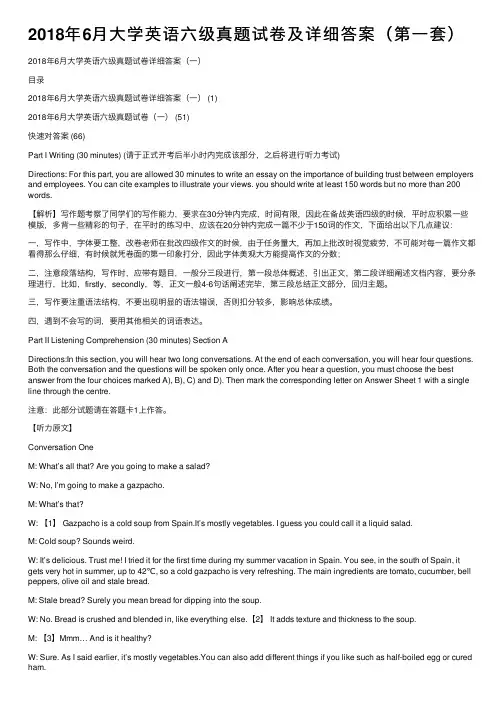
2018年6⽉⼤学英语六级真题试卷及详细答案(第⼀套)2018年6⽉⼤学英语六级真题试卷详细答案(⼀)⽬录2018年6⽉⼤学英语六级真题试卷详细答案(⼀) (1)2018年6⽉⼤学英语六级真题试卷(⼀) (51)快速对答案 (66)Part I Writing (30 minutes) (请于正式开考后半⼩时内完成该部分,之后将进⾏听⼒考试)Directions: For this part, you are allowed 30 minutes to write an essay on the importance of building trust between employers and employees. You can cite examples to illustrate your views. you should write at least 150 words but no more than 200 words.【解析】写作题考察了同学们的写作能⼒,要求在30分钟内完成,时间有限,因此在备战英语四级的时候,平时应积累⼀些模版,多背⼀些精彩的句⼦,在平时的练习中,应该在20分钟内完成⼀篇不少于150词的作⽂,下⾯给出以下⼏点建议:⼀,写作中,字体要⼯整,改卷⽼师在批改四级作⽂的时候,由于任务量⼤,再加上批改时视觉疲劳,不可能对每⼀篇作⽂都看得那么仔细,有时候就凭卷⾯的第⼀印象打分,因此字体美观⼤⽅能提⾼作⽂的分数;⼆,注意段落结构,写作时,应带有题⽬,⼀般分三段进⾏,第⼀段总体概述,引出正⽂,第⼆段详细阐述⽂档内容,要分条理进⾏,⽐如,firstly,secondly,等,正⽂⼀般4-6句话阐述完毕,第三段总结正⽂部分,回归主题。
三,写作要注重语法结构,不要出现明显的语法错误,否则扣分较多,影响总体成绩。
四,遇到不会写的词,要⽤其他相关的词语表达。
Part II Listening Comprehension (30 minutes) Section ADirections:In this section, you will hear two long conversations. At the end of each conversation, you will hear four questions. Both the conversation and the questions will be spoken only once. After you hear a question, you must choose the best answer from the four choices marked A), B), C) and D). Then mark the corresponding letter on Answer Sheet 1 with a single line through the centre.注意:此部分试题请在答题卡1上作答。
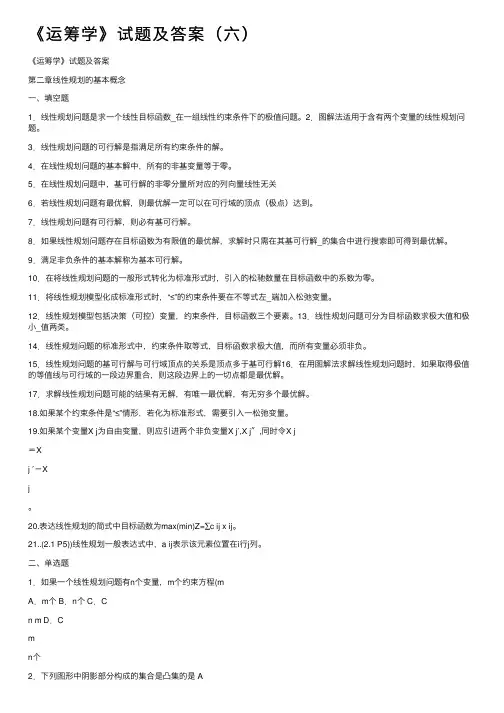
《运筹学》试题及答案(六)《运筹学》试题及答案第⼆章线性规划的基本概念⼀、填空题1.线性规划问题是求⼀个线性⽬标函数_在⼀组线性约束条件下的极值问题。
2.图解法适⽤于含有两个变量的线性规划问题。
3.线性规划问题的可⾏解是指满⾜所有约束条件的解。
4.在线性规划问题的基本解中,所有的⾮基变量等于零。
5.在线性规划问题中,基可⾏解的⾮零分量所对应的列向量线性⽆关6.若线性规划问题有最优解,则最优解⼀定可以在可⾏域的顶点(极点)达到。
7.线性规划问题有可⾏解,则必有基可⾏解。
8.如果线性规划问题存在⽬标函数为有限值的最优解,求解时只需在其基可⾏解_的集合中进⾏搜索即可得到最优解。
9.满⾜⾮负条件的基本解称为基本可⾏解。
10.在将线性规划问题的⼀般形式转化为标准形式时,引⼊的松驰数量在⽬标函数中的系数为零。
11.将线性规划模型化成标准形式时,“≤”的约束条件要在不等式左_端加⼊松弛变量。
12.线性规划模型包括决策(可控)变量,约束条件,⽬标函数三个要素。
13.线性规划问题可分为⽬标函数求极⼤值和极⼩_值两类。
14.线性规划问题的标准形式中,约束条件取等式,⽬标函数求极⼤值,⽽所有变量必须⾮负。
15.线性规划问题的基可⾏解与可⾏域顶点的关系是顶点多于基可⾏解16.在⽤图解法求解线性规划问题时,如果取得极值的等值线与可⾏域的⼀段边界重合,则这段边界上的⼀切点都是最优解。
17.求解线性规划问题可能的结果有⽆解,有唯⼀最优解,有⽆穷多个最优解。
18.如果某个约束条件是“≤”情形,若化为标准形式,需要引⼊⼀松弛变量。
19.如果某个变量X j为⾃由变量,则应引进两个⾮负变量X j′,X j〞,同时令X j=Xj ′-Xj。
20.表达线性规划的简式中⽬标函数为max(min)Z=∑c ij x ij。
21..(2.1 P5))线性规划⼀般表达式中,a ij表⽰该元素位置在i⾏j列。
⼆、单选题1.如果⼀个线性规划问题有n个变量,m个约束⽅程(mA.m个 B.n个 C.Cn m D.Cmn个2.下列图形中阴影部分构成的集合是凸集的是 A3.线性规划模型不包括下列_ D要素。
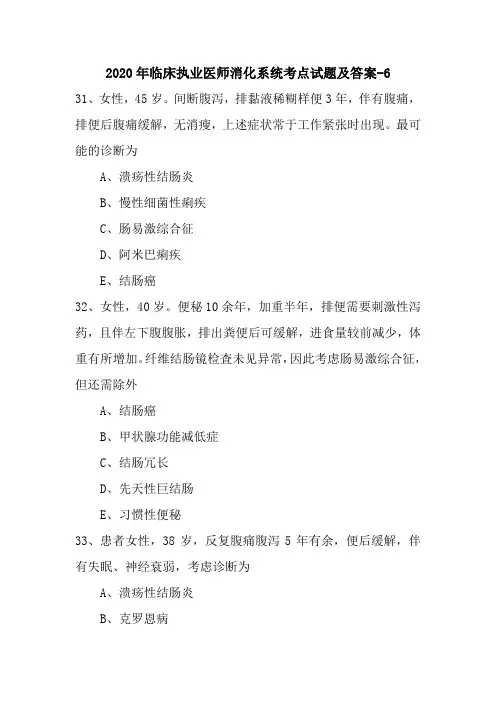
2020年临床执业医师消化系统考点试题及答案-631、女性,45岁。
间断腹泻,排黏液稀糊样便3年,伴有腹痛,排便后腹痛缓解,无消瘦,上述症状常于工作紧张时出现。
最可能的诊断为A、溃疡性结肠炎B、慢性细菌性痢疾C、肠易激综合征D、阿米巴痢疾E、结肠癌32、女性,40岁。
便秘10余年,加重半年,排便需要刺激性泻药,且伴左下腹腹胀,排出粪便后可缓解,进食量较前减少,体重有所增加。
纤维结肠镜检査未见异常,因此考虑肠易激综合征,但还需除外A、结肠癌B、甲状腺功能减低症C、结肠冗长D、先天性巨结肠E、习惯性便秘33、患者女性,38岁,反复腹痛腹泻5年有余,便后缓解,伴有失眠、神经衰弱,考虑诊断为A、溃疡性结肠炎B、克罗恩病C、肠结核D、肠易激综合征E、慢性细菌性痢疾34、女,60岁。
全腹胀痛3个月,伴渐进性排便困难,从每日1次到2~3天1次大便,大便有黏液或带血。
体检:贫血貌、腹膨隆、未见肠型、肠鸣音亢进、未及肿块,其诊断最可能是A、回盲部结核B、粘连性肠梗阻C、溃疡性结肠炎D、降结肠癌E、家族性息肉病35、男,65岁。
低热伴右侧腹痛不适半年。
查体:贫血貌,右侧中腹部扪及6cm×4cm质硬肿块,可推动,压痛不明显。
最可能的诊断是A、肠结核B、盲肠套叠C、右肾肿瘤D、升结肠癌E、阑尾周围脓肿36、男性,36岁,半年来,时有腹泻与便秘,3个月来腹部有隐痛,近两天大量便鲜血,直肠指诊和腹部触诊没有发现异常,X 线钡透检查见,距肛门约25cm处肠腔有约4.0cm,充盈缺损,近端肠腔有扩张,诊断应考虑为A、直肠壶腹癌B、升结肠结核C、乙状结肠癌D、降结肠结核E、溃疡性结肠炎37、女性18岁,因下腹部隐痛月余就诊,低热腹泻,贫血外观,右下腹触及肿块,压痛明显,白细胞10×109/L,血沉25mm/小时,既往有结核病史,X线腹平片检查,小肠多处小液气平面,钡灌肠盲肠充盈缺损,粘膜破坏,阑尾未充盈,为明确诊断进一步检查应作A、腹部B超B、纤维结肠镜C、选择性肠系膜血管造影D、腹部CTE、放射性核素显像38、男性,45岁。
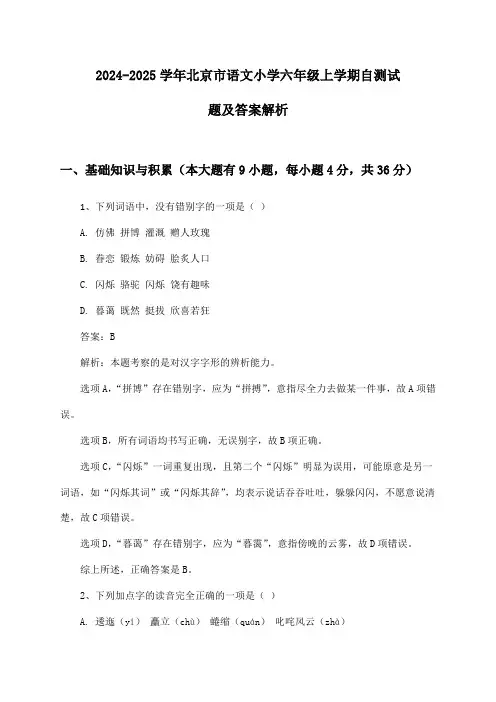
2024-2025学年北京市语文小学六年级上学期自测试题及答案解析一、基础知识与积累(本大题有9小题,每小题4分,共36分)1、下列词语中,没有错别字的一项是()A. 仿佛拼博灌溉赠人玫瑰B. 眷恋锻炼妨碍脍炙人口C. 闪烁骆驼闪烁饶有趣味D. 暮蔼既然挺拔欣喜若狂答案:B解析:本题考察的是对汉字字形的辨析能力。
选项A,“拼博”存在错别字,应为“拼搏”,意指尽全力去做某一件事,故A项错误。
选项B,所有词语均书写正确,无误别字,故B项正确。
选项C,“闪烁”一词重复出现,且第二个“闪烁”明显为误用,可能原意是另一词语,如“闪烁其词”或“闪烁其辞”,均表示说话吞吞吐吐,躲躲闪闪,不愿意说清楚,故C项错误。
选项D,“暮蔼”存在错别字,应为“暮霭”,意指傍晚的云雾,故D项错误。
综上所述,正确答案是B。
2、下列加点字的读音完全正确的一项是()A. 逶迤(yí)矗立(chù)蜷缩(quán)叱咤风云(zhà)B. 凛冽(lǐn)抽搐(chù)镌刻(juān)戛然而止(gá)C. 镌刻(juàn)瞭望(liào)踉跄(qiàng)惟妙惟肖(xiào)D. 踌躇(chú)蹒跚(pán)拗口(ào)囫囵吞枣(hún)答案:A解析:本题考察的是对汉字字音的掌握情况。
选项A,所有加点字的读音均正确,无误,故A项正确。
选项B,“戛然而止”的“戛”字读音错误,应读“jiá”,而非“gá”,故B项错误。
选项C,“镌刻”的“镌”字读音错误,应读“juān”,而非“juàn”,故C项错误。
选项D,“拗口”的“拗”字读音错误,此处应读“ào”,但在此词中应读“ào”的第三声“ǎo”,表示说起来别扭,不顺口,而非“ào”,故D项错误。
综上所述,正确答案是A。
浙江省2023年6月普通高校招生选考模拟考试地理试题一、选择题组读某国本土人口密度示意图(图中柱子越高表示人口密度越大,实线构成的U字形边界被称为该国人口“胡焕庸线”)。
据此完成下面小题。
1.关于该国人口分布特点的描述,正确的是()A.人口分布均衡,城乡人口密度差距小B.人口分布不均,大平原人口密度最大C.人口分布不均,亚热带人口密度最大D.人口分布不均,U字形内人口密度小2.关于该国四个区域人口分布特征形成的主导因素正确的是()A.①气候和地形B.②水源和植被C.③气候和地形D.④土壤和水文下图是贵州省双河洞地区喀斯特地貌演变及水系变迁示意图。
据此完成下面小题。
3.目前阶段所示地区()A.岩石类型多为玄武岩B.因地壳抬升形成干谷C.地表水下渗导致地下水埋深变深D.流水作用导致地表更加崎岖4.该喀斯特地貌区经济发展曾经困难重重,其原因可能是()①气候干旱②热量不足③土壤贫瘠④耕地紧缺A.①②B.②③C.③④D.①④国家公园是由国家批准设立并主导管理,以保护大面积自然生态系统为主要目的的特定区域。
2021年10月12日,在昆明召开的联合国《生物多样性公约》第15次缔约方大会上,中国正式宣布设立首批国家公园,下表为我国首批部分国家公园及所在位置。
据此完成下面小题。
5.首批国家公园中()A.①——湿地遍布,冻土发育B.②——草原广袤,物种丰富C.③——地势平坦,起伏较小D.④——全年高温,降水均匀6.推进国家公园建设()A.需加大兴建旅游设施B.应将治理大气污染作为首要任务C.可缓解城市热岛效应D.利于培养社会公众的生态文明观在秘鲁南部的沿海地区一个距海岸仅0.5千米的山坡上,有一张长12米、高4米的大网,下方有水槽可以把网上流下的水引向一个蓄水池。
据此完成下面小题。
7.当地居民利用此设施收集的水资源及成因是()A.积雪融水,冬季低温积雪量大B.雨水,赤道低气压带控制,降水丰富C.冰川融水,山地高耸冰川广布D.海雾,寒流流经海雾频发,水汽充足8.图中海区水温异常升高时以下说法正确的是()A.秘鲁渔场增产B.印尼上升气流加强C.智利降水增加D.西太平洋台风偏多下图是我国某城市月均热岛强度和气象用电量强度季节分布图。
《计算机图形学》练习试题及答案一、名词解释1、齐次坐标系2、光顺性3、种子填充算法4、镜面反射光5、投影变换6、光线跟踪7、复合变换8、走样9、几何造型技术10、虚拟现实二、简答题1、前截面距离F和后截面距离B定义了什么?2、计算机动画的制作主要步骤3、计算机图形显示器和绘图设备表示颜色的方法各是什么颜色系统?它们之间的关系如何?4、图形软件主语言的选择应考虑哪些因素?5、制定CGI,CGM,IGES标准的目的分别是什么?6、自由曲面的表示通常有哪两种?7、什么叫做走样?什么叫做反走样?反走样技术包括那些?8、简述区域连贯性、扫描线的连贯性以及边的连贯性。
9、简述Bezier曲线的不足之处。
10、建立图形软件可采用哪三种方法?11、在观察空间中,如何确定投影的类型和方向?12、简述编码裁剪法(即Cohen-Sutherland线段裁剪法)的算法过程。
三、应用题1、分析边标志算法的实现过程,并写出其算法的C语言描述。
2、简述深度缓存算法及其特点。
3、假设在观察坐标系下窗口区的左下角坐标为(wxl=10,wyb=10),右上角坐标为(wxr=50,wyt=50)。
设备坐标系中视区的左下角坐标为(vxl=10,vyb=30),右上角坐标为(vxr=50,vyt=90)。
已知在窗口内有一点p(20,30),要将点p映射到视区内的点p`,请问p`点在设备坐标系中的坐标是多少?(本题10分)4、如下表是采用DDA算法画出(0,0)到(5,2)的直线的数据,请填写空格处。
i xi yi yi+0.5 int(yi+0.5)1 0 0 0.5 02 13 24 35 46 5 2 2.5 25、已知三角形ABC各顶点的坐标A(1,2)、B(5,2)、C(3,5),相对直线Y=4做对称变换后到达A’、B’、C’。
试计算A’、B’、C’的坐标值。
(要求用齐次坐标进行变换,列出变换矩阵)6、试对下图中的多边形进行裁剪,用图表示裁剪过程。
人教版六年级上册英语试题及答案电子版六年级上册英语试题Listening Part(听力部分)一、听音,选择你所听到的单词或短语。
( ) 1. A. science B. straight C. street( ) 2. A. slow down B. on foot C. by bus( ) 3. A. next week B. take a trip C. comic book( ) 4. A. traffic light B. get together C. moon cake( ) 5. A. puzzle B. hobby C. pen pal( ) 6. A. worker B. head teacher C. reporter( ) 7. A. angry B. sad C. afraid( ) 8. A. see a doctor B. count to ten C. pay attention to( ) 9. A. turn B. stop C. visit( )10. A. country B. gym C. grass二、选出你所听到句子中含有的单词或短语。
( )1. Jim goes to Beijing ________ .A. by shipB. by subwayC. by train( )2. _______ at a red light.A. StopB. trafficC. Wait( )3.I’m going to see a film _______ .A. tonightB. tomorrowC. next week( )4.He is a ________ .A. post manB. factory workerC. businessman( ) 5. You should_____________.A. see a doctorB. do morning exerciseC. wear warm clothes三、听录音,选出你所听到的句子。
第二部份通用技术(共50分)一、选择题(本大题共13小题,每小题2分,共26分。
每小题列出的四个备选项中惟独一个是符合题目要求的,不选、多选、错选均不得分)1.如图所示是一种恒温电烙铁。
从人机关系的角度,下列分析中不正确的是A.手柄尺寸的确定,考虑了人的静态尺寸B.通电时指示灯发光,考虑了信息的交互C.手柄采用绝缘材料制作,实现了人机关系的安全目标D.电线防折护套的设计,实现了人机关系的高效目标第1题图第2题图2.如图所示是一款手持充电式紫外线杀菌器及其评价坐标图。
根据坐标图,下列分析中不恰当的是A.采用紫外线杀菌,灭菌效果较好B.价格高C.折叠后尺寸较小,携带方便D.续航时间普通3.如图所示是一款钢索夹紧装置。
为了提高夹紧的可靠性,需要增加一个连接件,下列方案中合理的是开口螺栓第3题图螺母B C DA4.下列钳工工具搭配使用不合理的是A B C D 通用技术课上,小明设计了如图所示的零件。
请根据题图完成第5-6题。
5.图中漏标的尺寸共有A.3 处B.4 处C.5 处D.6 处第5-6题图6.用厚度为8mm 的钢板制作该零件,下列加工流程中合理的是 A.划线 →冲眼 →钻孔 →锯割 →锉削 →淬火 B.划线 →锯割 →锉削 →淬火 →冲眼 →钻孔 C.划线 →冲眼 →钻孔 →淬火 →锯割 →锉削 D.划线 →锯割 →锉削 →钻孔 →冲眼 →淬火7.如图所示的连杆机构,在力Fi 、F ₂ 的作用下机构处于平衡状态,下列分析中正确的是 A. 连杆1受拉、摆杆2受压、机座立杆受压和受弯曲 B. 连杆1受拉、摆杆2受压、机座立杆受拉和受弯曲 C.连杆1受压、摆杆2受拉、机座立杆受拉和受弯曲 D.连杆1受压、摆杆2受拉、机座立杆受压和受弯曲如图a 所示是某自动对位控制系统的示意图。
其工作过程:摄像机连续获取被测物体的实时位置信息 (如图b 所示),工控机将接收到的位置信息不断与设定位置进行比较,计算出被测物体的偏移值,控制平 台驱动器驱动平台挪移和转动,使被测物体运动到设定位置(如图c 所示)。
描绘秋思:350字散文——落叶的诗意描绘In the serene tapestry of nature's palette, autumn weaves its enchanting narrative with hues of gold and rust. The air, a symphony of crisp whispers, carries the whispered secrets of the season. As I stroll beneath the rustling canopies, leaves transform into poets, their sentences etched in vibrant colors, telling tales of bygone days.Each leaf, a delicate page, whispers of summers past, their verdant green now bled into ochre and crimson. They pirouette gently, a dance of farewell to the sun, their descent a silent ode to the fleeting beauty of life. Their rustling whispers, like melancholic lullabies, soothe the soul, evoking introspection and contemplation.The earth, their stage, receives these fallen performers with a tender embrace, their decay a testament to the cycle of growth and decay. The scent of damp earth mingling with the aroma of decaying leaves, it's a heady mix of nostalgia and anticipation. It's a reminder that even in the face of change, life persists, rejuvenating in the fertile soil beneath.As I ponder these musings, I am reminded of the wisdom in letting go, just as the leaves do. Each leaf's fall is not an end, but a transition, a metaphor for resilience and rebirth. In the quiet solitude of autumn, one can find solace in the beauty of impermanence, a lesson in embracing the present while cherishing memories.中文翻译:在大自然宁静的画卷中,秋天以其金黄与暗红交织的故事讲述。
1510-全国-社会学概论总分:100一、单选题(共30题,共30分)1、孔德实证主义社会学的两个核心概念是()(1分)A:社会和自然B:秩序和进步C:结构和稳定D:发展和变迁2、社会学家马克斯·韦伯来自()(1分)A:法国B:美国C:德国D:英国3、刘易斯·A·科塞的代表著作是()(1分)A:《社会行动的结构》B:《社会理论的结构》C:《冲突的社会功能》D:《工业社会的阶级和阶级矛盾》4、法兰克福学派所主张的理论道路是()(1分)A:社会批判理论B:激进主义理论C:社会有机体理论D:后现代主义理论5、《区隔》一书的作者是法国社会学家()(1分)A:米歇尔·福柯B:尤尔根·哈贝马斯C:皮埃尔·布迪厄D:艾尔弗雷德·舒茨6、在社会学的研究方法中,以某个社会单位或案例为一个整体,进行详细考察的方法是()(1分)A:个案研究B:文献法C:实验法D:统计调查7、定性分析资料整理的三个步骤是()(1分)A:审查、分类和汇总B:汇总、分类和审查C:审查、汇总和分类D:分类、审查和汇总8、人口的双重属性是()(1分)A:物质属性和精神属性B:自然属性和社会属性C:政治属性和经济属性D:结构属性和过程属性9、从文化传播开始的两种文化之间互相沟通、采借、冲突与融合的过程称为()(1分) A:文化整合B:文化交流C:文化合作D:文化结构10、仅为社会上一部分成员所接受的或为某一地区、某一群体特有的文化被称为()(1分) A:附属文化B:边缘文化C:副文化D:亚文化11、人在成年以后的社会化被称为()(1分)A:初级社会化B:重新社会化C:继续社会化D:反向社会化12、米德将自我分为()(1分)A:两个部分B:三个部分C:四个部分D:五个部分13、根据角色追求的目标,可以将社会角色划分为()(1分)A:先赋角色与自致角色B:规定性角色与开放性角色C:目的性角色与过程性角色D:功利性角色与表现性角色14、在合作的类型中,大学生在老师的指导下进行的社会实践属于()(1分)A:指导性合作B:制度化的传统合作C:契约式合作D:自发性合作15、在社会互动的理论中,用表演和比喻来说明日常生活中人与人之间相互作用的一种互动理论是()(1分)A:日常互动论B:拟剧论C:符号互动论D:常人方法学16、由父母和多对已婚子女以及孙(外孙)子女组成的家庭被称为()(1分)A:联合家庭B:主干家庭C:重组家庭D:核心家庭17、以成员对群体的心理归属为标准,群体可以分为()(1分)A:初级群体和次级群体B:正式群体和非正式群体C:内群体和外群体D:大群体和小群体18、在组织过程中,组织成员从两个以上的行动方案中进行选择决断,以期最优化地达到组织目标的过程称为()(1分)A:组织设计B:组织沟通C:组织控制D:组织决策19、在解释集体行为的理论中,斯梅尔瑟提出的是()(1分)A:搭便车理论B:价值累加理论C:资源动员理论D:乌合之众理论20、人们在转换工作过程中的失业被称为()(1分)A:摩擦性失业B:结构性失业C:周期性失业D:残余性失业21、在消费的社会学理论中,韦伯提出的是()(1分)A:消费文化论B:消费社会论C:生活风格理论D:炫耀性消费理论22、在关于城市空间结构的理论中,扇形理论的提出者是()(1分)A:伯吉斯B:霍伊特C:林顿D:哈里斯23、在世界城镇化演进模式中,政治主导型城镇化被称为()(1分)A:墨印模式B:北欧模式C:欧美模式D:南美模式24、城市市区人口尤其大城市市区人口郊区化、大城市外围的卫星城镇布局分散化的城镇化被称为()(1分)A:过度城镇化B:反城镇化C:逆城镇化D:低度城镇化25、在城市群研究中,琼·戈特曼提出的是()(1分)A:城市群理论B:组合城市理论C:区域整体发展理论D:城市集中发展理论26、以血统、血缘和职业为标准,将社会成员划分为不同群体和社会集团的社会等级制度,被称为()(1分)A:等级B:种族C:阶层D:种姓27、根据毛泽东撰写的《中国社会各阶级的分析》一文的分析框架,新中国成立前的阶级阶层结构可划分为()(1分)A:五个阶级B:六个阶级C:七个阶级D:八个阶级28、拒绝社会提供的目标。
第6章卧室的设计试
一、填空题
1.主卧室是房屋主人的私人生活空间,它不仅要满足双方情感与志趣上的共同理想,而且也必须顾及夫妻双方的个性需求。
2.卧室的主要功能是休息、睡眠。
3.主卧室布置的基本要求是高度的安定感和私密性。
4.儿童房设计时保证一个阅读与书写的活动中心外,在有条件的情况下,依据孩子不同兴趣与性别特点,设立手工制作台试验台梳妆台、饲养角等方面的家具设施。
5.老人房的居室色彩选择应偏于古朴、平和、沉着的室内装饰色。
二、选择题
1.儿女卧室分为(ABCD )。
A.儿童期卧室B.青春期卧室C.幼儿期卧室D.婴儿期卧室2.老年房的装饰色彩(BCD )。
A.黄色B.米黄色C.淡蓝色D.淡灰色
3.卧室的采光要求取决于(ABC )。
A.朝向B.季节C.颜色D.环境
4.卧室的主要功能(CD )。
A.视听B.阅读C.休息D.睡眠
5.卧室的位置( C )
A.卫生区B.用餐区C.私密区D.公共区
三、判断题
1.青少年期卧室宜充分显示其学业与职业特点,并应在结合自身的性格因素与业余爱好方面、求职特点的形式表现。
()
2.睡眠区中的“共享型”就是共享一个公共空间进行睡眠休息等活动。
()3.老年人的一大特点是好静,另一特点是喜欢加快过去的事情。
()4.卧室的装饰色彩仅取决于季节。
()
5.卧室休闲区在卧室内满足人视听、阅读、睡眠活动为主要内容的区域。
四、简答题
1.怎样进行青少年房间的装饰?
答:根据青少年性别以及性格的特证进行装饰,在满足睡眠,学习的功能性之外可以依据个人的兴趣爱好设计一些小品,起到睡眠,学习,娱乐多重功能,、色调可根据年龄的不同来分类,比如儿童多倾向较鲜明的颜色,纯度高,对比强
等,而少年已接近半成熟期,色彩以中性色彩为主色调。
2.室内设计中如何照顾到老年人的特点?
3.卧室设计的功能与区位的划分如何进行?
附:答案
第6章
一、填空题
1.私人生活空间情感志趣个性
2.休息睡眠
3.私密性安定感
4.兴趣性别实验台饲养角梳妆
5.古朴平和沉着
二、选择题
1.ABCD 2.BCD 3.ABC 4.CD 5.C
三、判断题
1.√2.√3.√4.×5.×。